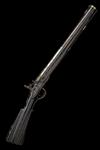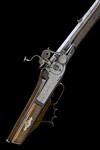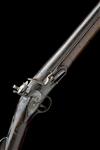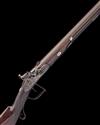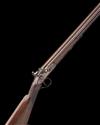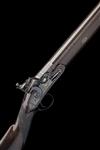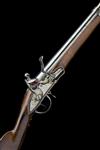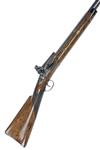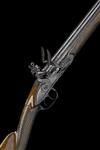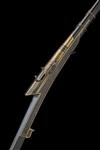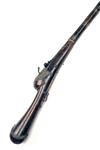goes:
The history of pattern welded shotgun barrels starts about 125 years after Alexander the Great made it to India, where Wootz/ Bulat/ Crucible steel was first forged 200 B.C.E. Etruscan smiths had been laminating blades for 400 years, but Wootz was a vastly superior product and the surface of finished weapons showed a pattern called “watering,” “firind," or "jawhar.”
Possibly in an attempt to reproduce these patterns, smiths layered thin sheets of iron and steel which were repeatedly folded and hammer welded, then treated with an etching agent (at first citrus juices) to enhance the contrast. By the sixth century, pattern welded swords had made their way to Northern Europe. Crusaders returned home from the Middle East 1096 to 1270 bearing both scars and samples of these Damascus blades.
About 1200 the first iron musket barrels were produced by folding a sheet of iron over a mandrel and hammer welding the long edge. At some point pattern welded sword methodology was applied to gun barrel methodology - twisting rods composed of thin layers of iron and steel, wrapping the rods around a mandrel, and hammer welding the edges. By the early 1600s, pattern welded gun barrels were being produced in India and Turkey, and examples exist of mid-1600s Turkish Miquelet barrels clearly showing a Four Iron Crolle pattern.
By 1634 Hungarian gunmaker Caspar Hartmann made Damascus barrels for King Gyorgy Rakoczi I and by 1650 Spanish makers produced pattern welded barrels during the reign of Philip IV. With the defeat of Kara Mustafa Pasha by Jan III Sobieski at Vienna in 1683, thousands of pattern welded gun barrels were available for examination by armourers throughout Western Europe. By 1700, Liege was producing Twist barrels and Crolle Damascus by about 1750. After Gen. Napoleon Bonaparte’s expedition against the Mameluks in Egypt and Ottomans in Syria 1798-1799, production of Damascus barrels in St. Etienne and Liege was markedly expanded.
J. Jones was granted a British patent in 1806 for a method of making barrels from scelps or strips coiled around a mandrel and by 1817 Rigby of Dublin was producing Damascus barrels. “Damascus iron” was manufactured in Birmingham by Wiswould and Adams about 1820. The last barrel maker in London was W. Fullard, of Clerkenwell, who ceased operations in 1844. From 1845 to 1855 John Dive's mill at Birmingham produced large quantities of “figured” barrels.
Pattern Welded shotgun barrels can be classified into three general categories, all starting with pieces of iron and steel, but with different manufacturing methodology: Twist (thin ribbons of layered iron and steel which were NOT twisted before being wrapped around the mandril and hammer forged), Crolle Damascus in many patterns (determined by how the iron and steel were layered in the billet and the twisting of the rods), and Laminated Steel (a higher ratio of steel to iron mixed together and ‘puddled’ before being formed into rods.)
Stub Twist (made from iron horse shoe nail stubs and chopped up coach spring steel), Plain Twist, and an early form of Laminated Steel were used for quality British gun barrels into the 1860s. Crolle Damascus was available in the late 1820s, but Two Iron large scroll “English Two Stripe” was not in general use until the mid-1800s, and along with Three Iron “Oxford” and a later Laminated Steel was used c. 1850-1890s. Four Iron “Turkish” appeared after 1870, although most 'Best Guns' used Three Iron. Lower quality English guns used Plain Twist/Skelp into the early 1900s.
William Wellington Greener in The Gun and Its Development admitted that the great majority of unfinished tubes used by both Birmingham and London makers were obtained from Liege but…“With the English maker the figure of the barrel is the last thing to be considered when determining the type most fit for the particular purpose, whereas with the foreign manufacturer it is usually the first, and often the only consideration. The English maker takes a barrel that will do best; the foreign maker the barrel that will look best.” Leopold Bernard (1832-1867) and Rene Leclerc were barrel makers in Paris and responsible for many of the patterns seen on barrels produced in France, Liege, and Ferlach. Ernest Heuse-Lemoine (1834-1926) from Nessonvaux was a major barrel agent and maker in the Vesdre Valley and maintained representatives in London, Birmingham, and New York. He named “Boston” and “Washington” Damascus (patterns) especially for the American market.
Damascus barrel production ceased in England in 1903 according to Greener, while in 1906 Liege produced 850 tons of Damascus barrels; 100 tons for export. Damascus production ended soon after August 7, 1914 when Liege fell to the invading German army.
What was the 'Damascus Road' that carried pattern welded barrel (not blade) technology from the Islamic world to Western Europe; St. Etienne, Liege, Brescia, Suhl, and the British Isles? It is likely there were two main 'highways': the Moors to Spain and eastward, and the Turks to Hungary and westward (and northeast to Russia.) But the knowledge and material traveled via many pathways with the free, though not entirely voluntary, exchange of military and mercenary, armourers, artisans (the Walloons?),merchants, and explorers from the Far East to West Africa.
Guns for the Sultan: Military Power and the Weapons Industry in the Ottoman Empire
"Between the fifteenth and seventeenth centuries, direct military conflicts, the employment of European military experts and, to a lesser degree, illegal trade in weaponry ensured relatively easy dissemination of up-to-date technologies and military know-how in the Sultan’s realms. Istanbul was more than a simple recipient of foreign technologies with its Turkish and Persian artisans and blacksmiths, Armenian and Greek miners and sappers, Turkish, Bosnian, Serbian, Hungarian, Italian, German, and later French, English and Dutch foundrymen and military engineers…Turkish, Arab and Persian blacksmiths added to their expertise of metallurgy techniques of the Islamic East..."
Last edited by Drew Hause; 04/11/10 05:58 PM. |
|
|
Hop To General Discussion ------ DoubleGun BBS @ doublegunshop.com DoubleGun FAQ @ doublegunshop.com DoubleGuns For Sale @ doublegun... Double Rifles, Paradox Guns &am... Classic & Custom Single Bar... German & Austrian Sporting ... DIY Gunsmithing @ doublegunshop.com Friends of the DoubleGun BBS @ ... Silent Doubles - In Memorium Gun Makers & Related Trade ... |
|
 5D5D52B8-9FDD-432D-BFBD-65430CB45854.jpeg96.2 KB
5D5D52B8-9FDD-432D-BFBD-65430CB45854.jpeg96.2 KB 41EBF7A3-D4B3-41E9-9F9E-109A80508AC8.jpeg96.3 KB
41EBF7A3-D4B3-41E9-9F9E-109A80508AC8.jpeg96.3 KB A57FCA17-8F62-4BB0-B05B-C481C1C4DF24.jpeg96.3 KB
A57FCA17-8F62-4BB0-B05B-C481C1C4DF24.jpeg96.3 KB 4B33D9E3-8EBF-4908-B2FB-1CF72BA8B638.jpeg93.7 KB
4B33D9E3-8EBF-4908-B2FB-1CF72BA8B638.jpeg93.7 KB CA03F945-BAC4-44B9-A8C2-3B6AEA90132A.jpeg92.7 KB
CA03F945-BAC4-44B9-A8C2-3B6AEA90132A.jpeg92.7 KB 84883411-F120-4765-B6C1-70ECFF899A65.jpeg91.3 KB
84883411-F120-4765-B6C1-70ECFF899A65.jpeg91.3 KB 570B8F44-59E0-4A8A-8AF6-69CA5BD0BB37.jpeg82.2 KB
570B8F44-59E0-4A8A-8AF6-69CA5BD0BB37.jpeg82.2 KB














